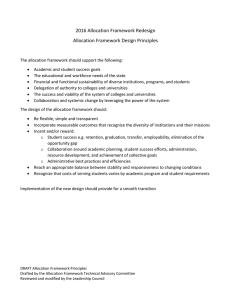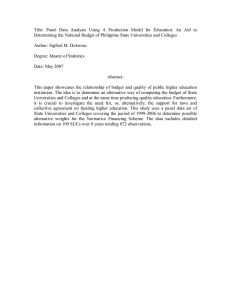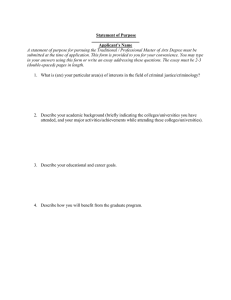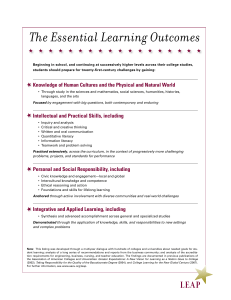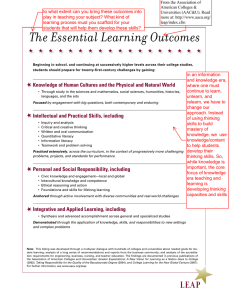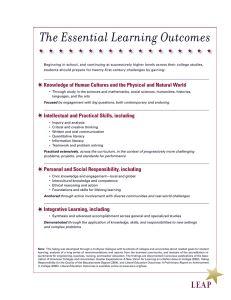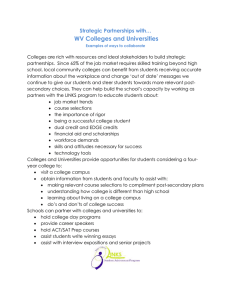Document 15919586
advertisement
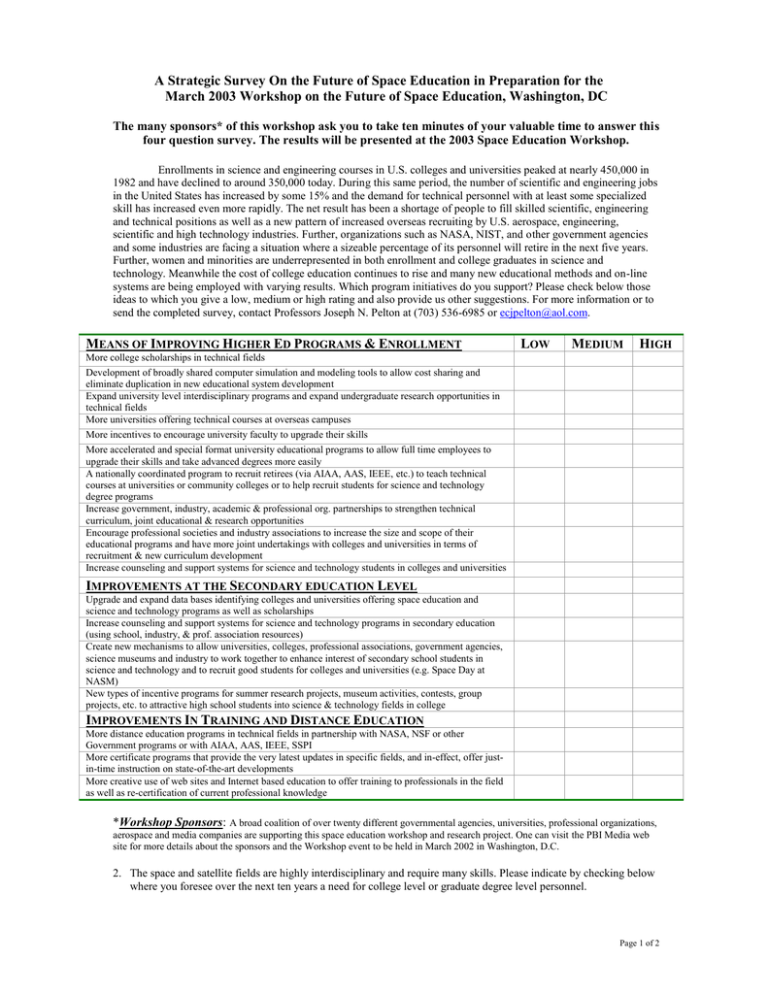
A Strategic Survey On the Future of Space Education in Preparation for the March 2003 Workshop on the Future of Space Education, Washington, DC The many sponsors* of this workshop ask you to take ten minutes of your valuable time to answer this four question survey. The results will be presented at the 2003 Space Education Workshop. Enrollments in science and engineering courses in U.S. colleges and universities peaked at nearly 450,000 in 1982 and have declined to around 350,000 today. During this same period, the number of scientific and engineering jobs in the United States has increased by some 15% and the demand for technical personnel with at least some specialized skill has increased even more rapidly. The net result has been a shortage of people to fill skilled scientific, engineering and technical positions as well as a new pattern of increased overseas recruiting by U.S. aerospace, engineering, scientific and high technology industries. Further, organizations such as NASA, NIST, and other government agencies and some industries are facing a situation where a sizeable percentage of its personnel will retire in the next five years. Further, women and minorities are underrepresented in both enrollment and college graduates in science and technology. Meanwhile the cost of college education continues to rise and many new educational methods and on-line systems are being employed with varying results. Which program initiatives do you support? Please check below those ideas to which you give a low, medium or high rating and also provide us other suggestions. For more information or to send the completed survey, contact Professors Joseph N. Pelton at (703) 536-6985 or ecjpelton@aol.com. MEANS OF IMPROVING HIGHER ED PROGRAMS & ENROLLMENT LOW MEDIUM HIGH More college scholarships in technical fields Development of broadly shared computer simulation and modeling tools to allow cost sharing and eliminate duplication in new educational system development Expand university level interdisciplinary programs and expand undergraduate research opportunities in technical fields More universities offering technical courses at overseas campuses More incentives to encourage university faculty to upgrade their skills More accelerated and special format university educational programs to allow full time employees to upgrade their skills and take advanced degrees more easily A nationally coordinated program to recruit retirees (via AIAA, AAS, IEEE, etc.) to teach technical courses at universities or community colleges or to help recruit students for science and technology degree programs Increase government, industry, academic & professional org. partnerships to strengthen technical curriculum, joint educational & research opportunities Encourage professional societies and industry associations to increase the size and scope of their educational programs and have more joint undertakings with colleges and universities in terms of recruitment & new curriculum development Increase counseling and support systems for science and technology students in colleges and universities IMPROVEMENTS AT THE SECONDARY EDUCATION LEVEL Upgrade and expand data bases identifying colleges and universities offering space education and science and technology programs as well as scholarships Increase counseling and support systems for science and technology programs in secondary education (using school, industry, & prof. association resources) Create new mechanisms to allow universities, colleges, professional associations, government agencies, science museums and industry to work together to enhance interest of secondary school students in science and technology and to recruit good students for colleges and universities (e.g. Space Day at NASM) New types of incentive programs for summer research projects, museum activities, contests, group projects, etc. to attractive high school students into science & technology fields in college IMPROVEMENTS IN TRAINING AND DISTANCE EDUCATION More distance education programs in technical fields in partnership with NASA, NSF or other Government programs or with AIAA, AAS, IEEE, SSPI More certificate programs that provide the very latest updates in specific fields, and in-effect, offer justin-time instruction on state-of-the-art developments More creative use of web sites and Internet based education to offer training to professionals in the field as well as re-certification of current professional knowledge *Workshop Sponsors: A broad coalition of over twenty different governmental agencies, universities, professional organizations, aerospace and media companies are supporting this space education workshop and research project. One can visit the PBI Media web site for more details about the sponsors and the Workshop event to be held in March 2002 in Washington, D.C. 2. The space and satellite fields are highly interdisciplinary and require many skills. Please indicate by checking below where you foresee over the next ten years a need for college level or graduate degree level personnel. Page 1 of 2 Desired Discipline Area BA or BS Low Level Need BA or BS Medium Level Need BA or BS High Level Need MS or PhD Low Level Need MS or PhD Medium Level Need MS or PhD High Level Need Lowest Level Need Lower Level Need Moderate Level Need Higher Level Need Important Level Need Highest Level Need Aerospace Engineering. Chemical & Materials Engineering Physical Sciences & Math Astrophysics Electrical Eng., IT & Telecommunications Space Applications (Remote Sensing, satcom,etc) Mechanical & Civil Engineering & Robotics Computer Science Life Sciences and BioTechnology Engineering or Technology Management Other Degree Programs of Interest Architecture and Systems Design Operational Research Business, Marketing, Contract Admin. and MIS/CIS Contract, Patent, Internat’l & Other Law Key Skill Areas Nano-Technology and MEMS Systems Robotics & Smart Systems Net Design Space Mission Design & Micro-gravity Computer Aided Design Artificial Intelligence & Expert Systems Risk Assessment Computer Prog (C++). & Data Base Mgt Internet, HTTP & Computer Graphics Languages (Sp., Fr, Ger. Chinese, etc.) International & Eng/Project Mgt. Skills BioInformatics 3. What do you see as the biggest problem or issue to be faced in education and training for the space and satellite industry? Problem/Issue Minor Medium Large Keeping current workforce up to date with new technology and knowledge in the field? (70% of all information in our global society has been created since the start of the Internet and is currently doubling every 3 years. This means 16 times more information than we have today by 2015.) Recruiting skill level positions to meet future government, industry or academic needs in the space and satellite industry. Relying more and more heavily of international pool of talent in spite of problems with security clearances, terrorist concerns, home leave, etc. Academic and training institutions not being able to provide the range, breadth, depth, specific skills and timeliness of curriculum needed to meet future development and implementation needs. High and rising cost of education and training. Lack of personnel trained to work in interdisciplinary teams, international cultures, and at systems design and management levels. 4. If you could make one improvement or create one new mechanism or process to improve space and satellite related education and training what would you do and how could this be best implemented? Page 2 of 2
